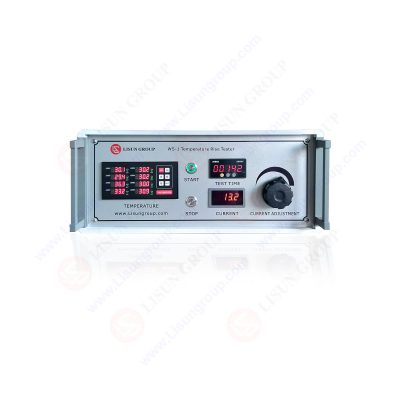

Temperature rise refers to the increase in temperature of various components of electronic and electrical devices relative to the ambient temperature. When a conductor is energized, its surface temperature rises over time due to the heat effect of the current, until it reaches a stable state. The rated temperature rise of a motor is the maximum allowable temperature rise of the winding under a specified ambient temperature (usually 40°C), which depends on the insulation class of the winding.
Evaluating temperature rise not only reflects the heat dissipation condition of the motor but also helps assess whether its thermal management is functioning properly. To verify the lifespan and stability of electronic products, temperature rise tests are commonly conducted on critical components (such as IC chips) by operating the device at temperatures above its rated operating temperature (e.g., 25°C) to a specified temperature (e.g., 70°C), recording the temperature rise above the ambient, and thus validating the design.
1. Significance of Temperature Rise Testing
Temperature rise testing is a standard procedure in electrical product type testing, primarily used to assess the temperature changes of electrical products and their components to ensure compliance with safety standards. With the rapid development of electrical product technology, temperature rise testing has become crucial in evaluating the safety of devices and components. Prolonged operation at high temperatures can degrade insulation material performance, potentially leading to electric shocks, burns, or fires. Therefore, temperature rise testing is a key measure to prevent these safety hazards.
2. Methods of Temperature Rise Testing
Temperature rise testing methods are generally classified into contact and non-contact measurements:
Non-Contact Measurement Methods
Non-contact methods measure the temperature of the surface of the object being tested and usually require correction for surface emissivity to obtain accurate temperatures. However, these methods are limited by factors such as distance between the object and the instrument, and the presence of water vapor, smoke, dust, etc., in the radiation path, which may reduce measurement accuracy. Common non-contact temperature measurement techniques include:
• Spectral Temperature Measurement: Determines temperature by measuring the spectrum of radiation emitted by the object’s surface.
• Holographic Interferometry: Utilizes interference phenomena to measure temperature changes.
• CCD-Based Tricolor Temperature Measurement: Uses a CCD camera to capture tricolor information to calculate temperature.
Contact Measurement Methods
Contact methods involve direct interaction with the object being tested and offer higher accuracy and reliability. Key temperature measurement elements include:
• Thermocouples: Based on the Seebeck effect, thermocouples measure temperature by the voltage generated from the temperature difference between two different materials at their junction.
• Resistance Temperature Detectors (RTDs): Measure temperature based on the change in electrical resistance with temperature.
Contact measurement methods are widely used due to their ability to directly measure the actual temperature of the object.
WS- 1_Temperature Rise Tester
3. Implementation of Temperature Rise Testing
Preparation Before Testing
• Equipment Calibration: All testing equipment should be calibrated annually. Calibration stickers should be affixed to instruments, indicating the last calibration date and cycle.
• Sample Inspection: Check the integrity of the sample, ensuring that components, accessories, and attachments are complete.
• Environmental Conditions: Place the sample in an environment with 23°C ±2°C and 50%-90% RH for 10 hours to allow its surface temperature to equilibrate with room temperature before testing.
Testing and Recording
• Achieving Thermal Equilibrium: The device or its components should run under normal load conditions until reaching thermal equilibrium, and temperature data at various points should be recorded.
• Data Recording: Record the temperature rise, voltage, current, input power, output voltage, output current, and output power of the tested product.
• Environmental Temperature Stability: Monitor the stability of the ambient temperature curve, ensuring fluctuations are within acceptable limits.
• Device Operating Status: If abnormalities (such as noise, sparks, vibrations, thermal protection, etc.) occur, immediately save the existing data, stop the test, analyze the cause, and resolve the issue.
• Curve Analysis: Examine the temperature curve changes at each test point. If abnormalities are detected, save the data and analyze the cause.
• Test Environment Management: Minimize personnel activity during testing, especially avoiding rapid movements to prevent affecting the ambient temperature and accuracy of the test results.
Through rigorous temperature rise testing, the safety and stability of electrical products in actual use can be effectively ensured, preventing potential risks caused by excessive temperature rise. https://www.lisungroup.com/news/technology-news/the-importance-and-methods-of-temperature-rise-testing-in-electronic-and-electrical-devices.html
.jpg)
Comments
Post a Comment